
The thrush nightingale, also known as the sprosser, is a small passerine bird that was formerly classed as a member of the thrush family Turdidae, but is now more generally considered to be an Old World flycatcher, Muscicapidae. It, and similar small European species, are often called chats.
Old World warblers are a large group of birds formerly grouped together in the bird family Sylviidae. The family held over 400 species in over 70 genera, and were the source of much taxonomic confusion. Two families were split out initially, the cisticolas into Cisticolidae and the kinglets into Regulidae. In the past ten years they have been the subject of much research and many species are now placed into other families, including the Acrocephalidae, Cettiidae, Phylloscopidae, and Megaluridae. In addition some species have been moved into existing families or have not yet had their placement fully resolved. A smaller family of warblers, together with some babblers formerly placed in the family Timaliidae and the parrotbills, are retained in a much smaller family Sylviidae.

The jungle prinia is a small passerine bird, a warbler in the family Cisticolidae.

The brown quail, also known as the swamp quail, silver quail and Tasmanian quail, is an Australasian true quail of the family Phasianidae. It is a small, ground-dwelling bird and is native to mainland Australia, Tasmania and Papua New Guinea and has been introduced to New Zealand and Fiji. Widespread and common throughout its large range, the brown quail is evaluated as being of "least concern" by the International Union for Conservation of Nature on the IUCN Red List of Threatened Species.

The brown songlark, also Australian songlark, is a small passerine bird found throughout much of Australia. A member of the family Locustellidae, this species is notable for sexual size dimorphism, among the most pronounced in any bird. It is a moderate-sized bird of nondescript plumage; the female brownish above and paler below, the larger male a darker brown.
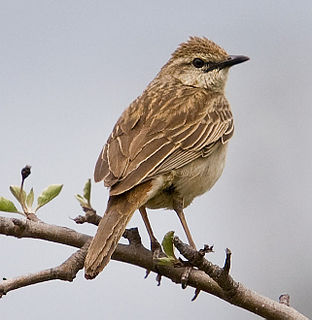
The songlarks are a pair of species of birds in the family Locustellidae. Most taxonomists place them together with the thicketbirds in the genus Cincloramphus. They are alternatively placed in the genus Megalurus.

Cincloramphus is a genus of birds in the grassbird family Locustellidae.

The Taiwan bush warbler is a species of Old World warbler in the family Locustellidae. It is found only in Taiwan. Its natural habitat is undergrowth and grassland 1,200–3,000 m (3,900–9,800 ft) in elevation. It was first recorded in 1917 and named as a distinct species in 2000. The International Union for Conservation of Nature (IUCN) has assessed it as a least-concern species.

The Barratt's warbler or African scrub warbler, is a species of Old World warbler in the family Locustellidae. It is found in eastern South Africa, Lesotho, eastern Zimbabwe and adjacent western Mozambique. Its natural habitat is subtropical or tropical moist montane forests.

The Middendorff's grasshopper warbler is a species of Old World warbler in the family Locustellidae. It breeds in eastern Siberia to northern Japan, Kamchatka Peninsula and northern Kuril Islands. It winters in the Philippines, Borneo and Sulawesi and in small numbers in China, Hong Kong, South Korea, Malaysia, Taiwan and the U.S.A.
The New Britain thicketbird or Bismarck thicketbird is a bird species. It used to be placed in the "Old World warbler" family Sylviidae, but it does not seem to be a close relative of the typical warblers; probably it belongs in the grass warbler family Locustellidae. It is found only in the rarely visited highlands of the island of New Britain in Papua New Guinea.
The Bougainville thicketbird is a bird species. It had been placed in the "Old World warbler" family Sylviidae, but it does not seem to be a close relative of the typical warblers; probably it belongs in the grass warbler family Locustellidae. It is endemic to Bougainville Island. Its natural habitat is subtropical or tropical dry lowland grassland. It used to be considered conspecific with the Santo thicketbird and the New Britain thicketbird.

The New Caledonia thicketbird or New Caledonia grassbird, is a bird species. Previously placed in the "Old World warbler" family Sylviidae, it does not seem to be a close relative of the typical warblers; probably it belongs in the grass warbler family Locustellidae. This species is endemic to New Caledonia.
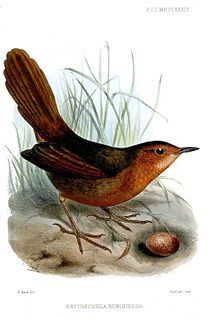
The rusty thicketbird is a bird species. Previously placed in the "Old World warbler" family Sylviidae, it does not seem to be a close relative of the typical warblers; probably it belongs in the grass warbler family Locustellidae. It is found in New Britain only.
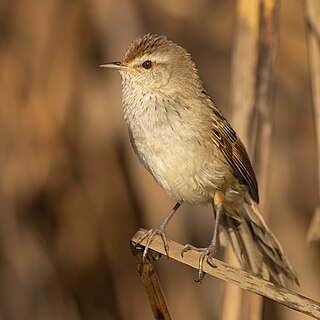
The little grassbird is a species of Old World warbler in the family Locustellidae. It is found in Australia and in West Papua, Indonesia. These sexually monomorphic birds are found in reed beds, rushes, lignum swamps and salt marshes of Southeastern Australia.
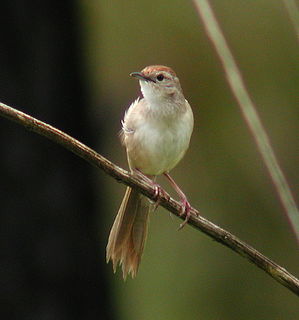
The tawny grassbird is a large songbird that is part of the grass- and bush-warbler family (Locustellidae) commonly found in grassland and reedbed habitats. It is streaked above and has a distinctive rich brown cap. Its underside is paler and it has a long graduated tail. They call often with "loud, grumpy churring calls and a longer call that starts “tick-tick-tick-tick” and ends with an explosive descending trill".
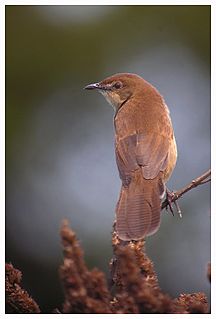
The broad-tailed grassbird is a species of Old World warbler in the family Locustellidae. It is endemic to the Western Ghats of India with a possibility of occurrence in Sri Lanka. A small, mostly brown bird, it has a broad rounded and graduated tail. It is found only on the higher altitude grassy hills where it usually skulks, except during the breeding season when males fly up into the air to sing in their display. The species is believed to be a resident although it is possible that they make local movements.

Locustellidae is a newly recognized family of small insectivorous songbirds ("warblers"), formerly placed in the Old World warbler "wastebin" family. It contains the grass warblers, grassbirds, and the Bradypterus "bush warblers". These birds occur mainly in Eurasia, Africa, and the Australian region. The family name is sometimes given as Megaluridae, but Locustellidae has priority.

The cricket warbler, also known as cricket longtail, scaly longtail or cricket prinia, is a species of bird in the family Cisticolidae. It belongs to the genus Spiloptila; it is often the only species included in the genus but sometimes the red-fronted prinia is placed there as well.

The Oriental cuckoo or Horsfields cuckoo is a bird belonging to the genus Cuculus in the cuckoo family Cuculidae. It was formerly classified as a subspecies of the Himalayan cuckoo, with the name 'Oriental cuckoo' used for the combined species. Differences in voice and size suggest that it should be treated as a separate species. The binomial name Cuculus horsfieldi has often been used instead of Cuculus optatus, but is now usually considered to be a junior synonym.


















